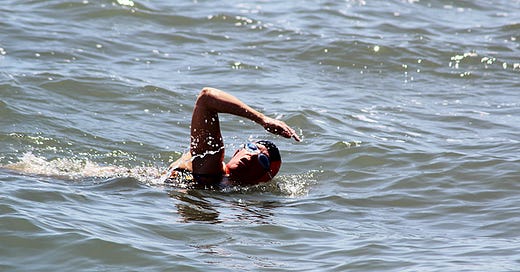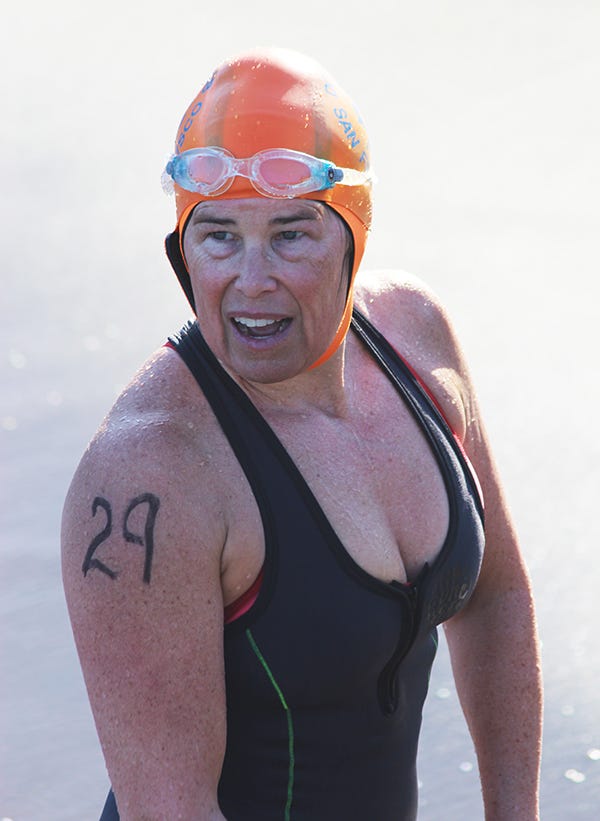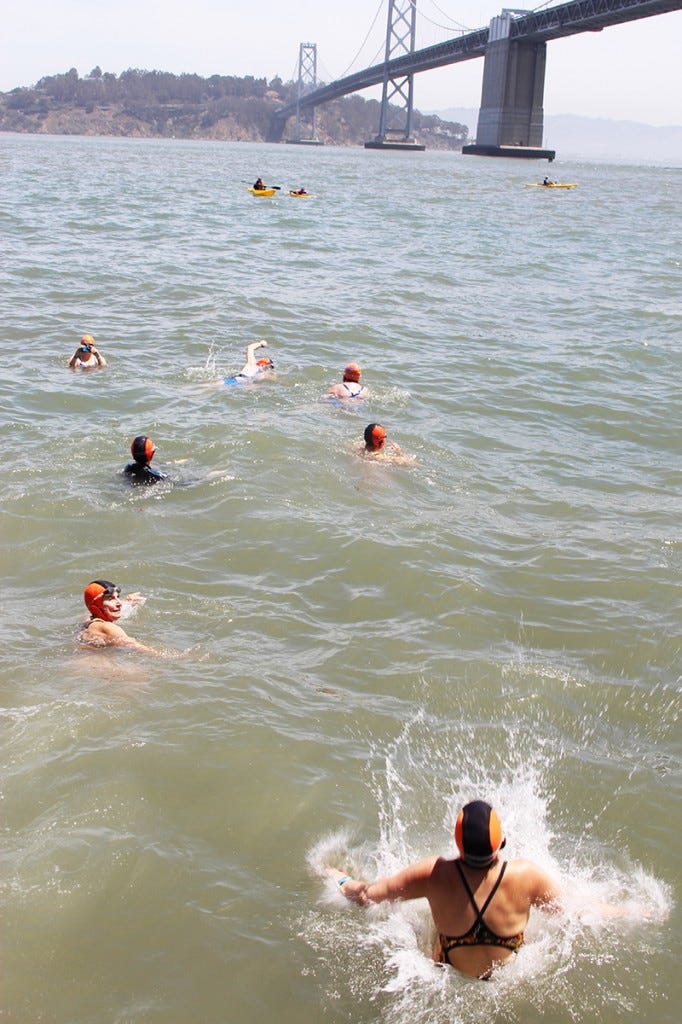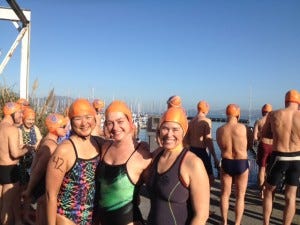The Scariest Thing in the Water is Me
Getting to My First One-Mile Open Water Swim Meant Facing My Fear
I wrote this after my first one-mile open water swim in 2014. This was my first taste of facing my fears and of what my body and mind could do if we worked together for something we loved: wild swimming. Ten years later, I am training for three August swims that each feel like a stretch for me. It feels uncomfortable. I’m not sure what the outcome will be, but I welcome the journey.
As I hopped off the dock at Gashouse Cove and into the San Francisco Bay, I knew that swimming in the 54-degree water could trigger a rush of adrenaline and a primitive, almost unbearable fight-or-flight response. But I felt happy, not fearful. This was the moment I had been working towards for weeks—and thinking about for more than a decade—my first one-mile swim in open water.
Swimming in open water like a bay or the ocean is fundamentally different from swimming in a pool. There are no lanes and no sides. Every swim is different, depending on the tide, the wind, the wildlife, and you. Once away from the shore, if you tire out or get scared or just plain want out, you might not have the option to quit right away.
I had finally had enough of being scared of something that I loved to do—swim in San Francisco Bay
What made me want to finally take on this goal that had spent years on my bucket list? I had turned 49 in January 2014 and decided that I had finally had enough of being scared of something that I loved to do—swim in San Francisco Bay. In fact, I had been swimming in the bay for more than 20 years, but I had never swum outside of Aquatic Park Cove, my swim club’s protected little corner of the bay that sits just below the former Ghirardelli chocolate factory in view of Alcatraz. Still subject to the strong tides and winds of the bay, the cove can be like a lake or a washing machine depending on the conditions. I wanted to challenge myself to go beyond my mostly self-imposed physical and mental limits and swim a mile in the open bay.
Haunted
I was coming off of a five-year stretch during which I had swum only sporadically. But my biggest obstacle wasn’t a lack of fitness. It was fear. Fear of dying/drowning. Fear of failure. Fear of fear.
Over the years, I’ve experienced several periods of panic attacks, including following the births of my three children. The adrenalin rush that the body experiences in cold water can mimic a budding panic attack and I’d had several in the water—all terrifying experiences when I was sure I would drown. These haunted me. I was afraid to swim too far from shore, or for too long, and over the years had created a complicated maze of safety behaviors that limited my swimming.
I realized that I needed to focus on one small step at a time and not get overwhelmed by the void I felt between where I was starting from and where I wanted to be.
I would have to train my body, but also organize my mind
Clarity. Goal. Plan.
To get me from the idea of the swim to the reality of hopping off a dock, I knew I would have to train my body, but also organize my mind. I found that these three steps helped me prepare:
Clarity: I was clear that I wanted to swim outside of my cove. It was a decade-long bucket list item. My club, the Dolphin Swimming & Boating Club, has an annual swim calendar where I would be supported and be safe.
Making a Specific Goal: After consulting with other club members, I chose the one-mile swim from Gashouse Cove, a little marina with a boat gas dock, just over the hill from our club. After the swim briefing, we would walk the mile to the cove, jump off the dock at the marina, swim out of the cove and into the open bay and catch the incoming flood tide which would give us a push back towards our own cove. At my scenic swim rate, I guessed it would take me about 40 minutes.
A Plan: I would have six weeks to train. I planned to build up my cold tolerance (the water temperature was in the low to mid-50s and my longest swim was about 10 minutes) and my endurance (the furthest I had swum was about a quarter of a mile) by swimming 3–4 times a week and adding 1–2 minutes to each swim.
A Coach
When you start talking to athletes, and especially endurance athletes, you learn that their mental attitude is key to their success, along with the discipline of training, and joy in what they are doing. But the ability to persevere through difficult moments, find resilience after a failure, and go beyond our comfort zone can apply to all of us—athlete or not. How do us regular folks learn to bring these concepts into our lives? There are many paths, but for me, it was working with a coach.
Not having been a student-athlete, I didn’t know what a coach could do for me. But luckily, I had one in mind.
I had met Leslie Thomas a decade earlier when I took a Total Immersion Swimming workshop in the hopes that I would finally learn to swim freestyle comfortably (I mostly sidestroke) and this would lead to an Alcatraz swim. It didn’t. But I did learn a lovely meditative form of swimming, which I was unable to transfer from the pool to the bay because I only felt safe doing the sidestroke.
Fast forward to 2014 when I reconnected in February with Leslie and began having weekly coaching sessions by phone.
We would talk about my training (adding minutes to each swim; where to swim) and about the logistics of the upcoming swim (how do I jump off a dock? what should I eat?). But mostly we would talk about why I wanted to do this swim and about my fear.
What, exactly, was I afraid of? What does this fear feel like? What does it say? What triggers it? What happens when it passes? What old “habit beliefs” might be interfering with the changes I wanted to make? How might I take a new approach to my fear when and if it arises? How could I be kinder to myself and find joy in what I was doing?
The Scariest Thing in the Water is Me
I started a swim journal, noting my time in the water, water temperature, currents, swim course, and how I felt. I read Fear: Essential Wisdom for Getting through the Storm by Zen master and Buddhist monk Thich Nhat Hanh, which examines the origins of fear and offers practices to greet it like an old friend, instead of a dreaded invader; and Open Water Swimming Manual: An Expert’s Survival Guide for Triathletes and Open Water Swimmers by swim legend Lynne Cox.
In the water, I was slowly lengthening my time. I learned that in the cold water my body went through several rounds of acclimation at about 7, 11, and 25 minutes that were potential trigger points for fear. But I was getting stronger too, and if I returned to shore after a scare, I felt like I had been cheated out of a longer swim that I knew I could do. I found that if I could gently greet my fear and just keep swimming another 10 or 25 strokes, I could come out the other side of it and feel OK.
When I would tell people what I was planning and about the long-held fears I was trying to overcome, they would say, “What about the cold water? What about sharks?” To me, however, the scariest thing in the water wasn’t the wildlife, it was me—or rather the part of my mind that was pulling me down old pathways of fear.
To work with this fear, I developed mantras and used visualizations. My swimming mantras were: I Can Do More Than I Think I Can; I Will Be Kind to Myself and My Fear if It Comes; Just Keep Swimming (like the anxiety-ridden Dory in “Finding Nemo”); and Enjoy. I visualized swimming into my cove from the bay and up to the Dolphin Club beach and getting my timing stick.
The Swim
The morning of the swim I woke up early and ate a bowl of oatmeal with banana, dried apricots, and walnuts. I felt jittery and nervous but also excited and happy. I had put in the training and I felt ready. It was a beautiful morning with no wind and the sun was rising over the East bay hills. My husband dropped me off at the club where it was abuzz with pre-race activity with about 70 swimmers getting ready.
I checked in and got a large number written on my left shoulder. I had already paid my annual club swim dues and joined Pacific Masters Swimming, part of the U.S. Masters Swimming group that provides insurance for club swims.
When I told some friends what I was trying to do, many offered to support me by being my swim angel and pilot. My friends Carolyn and Kerry and I walked along the promenade of Aquatic Park in the sun. Up and over Ft. Mason hill and down to the marina. And there, right across the road from the Marina Safeway, we hopped off the dock and into the water where the starting boat was already in position.
An air horn signaled the start of the race. I hung back to let the fast swimmers get out in front and made my way, side stroking, out of the marina and into the open bay where I found my swim pilot, Roxy, waiting for me with a smile and a wave. As we started east with the current, a rush of cold brought a wave of unease. I greeted it and kept breathing and counting strokes. To my left was my friend Kerry and to my right was Roxy on her paddle board, smiling and telling me how great I was doing and what was coming next. When I looked up, I realized that I was already almost at the start of the pier that protects our cove. I was halfway already! I had to swim a little harder to get inside the breakwater. Now I could see the beach! As I got closer I could hear my family on the dock, yelling “Go Pia!” I swam up to the beach with Kerry right next to me. “I did it!” I yelled at her and gave her a huge hug. I got my timing stick. I finished 60 out of 74 swimmers with a time of 28:51. My goal was to not die, finish, and have fun. Mission accomplished.
Note: It’s never too late to learn to swim, or to swim better. Your local public pool or the American Red Cross is a great place to start to look for a supportive instructor. If you want to try open water swimming, search for groups near you to get acquainted with local conditions. Always swim with a buddy.








What a beautiful process you have written about so clearly and eloquently and an amazing accomplishment from where I sit. Kudos to you Pia.
Yes! We can do hard things!!!! I am attempting my first 100 mile race (running) this summer and am slightly terrified as well. Love reading your process and thoughts. I am sharing this with a cold water swimmer friend in Michigan. I think she'd enjoy it. Speaking of. Have you heard of the Mackinac Island Swim and the Mackinac Bridge swim? Definitely cold water!!!